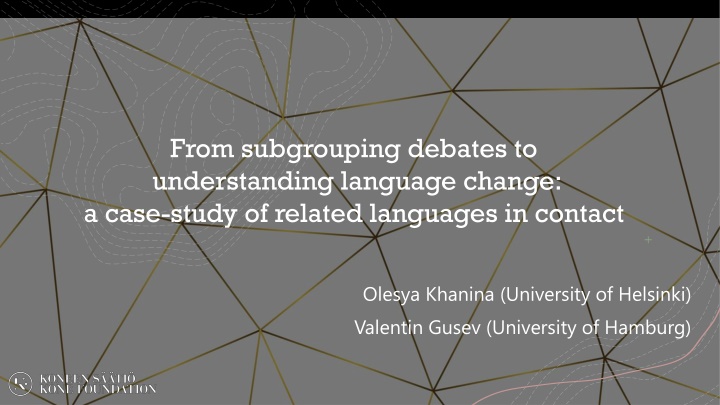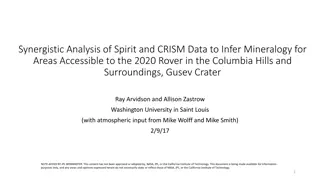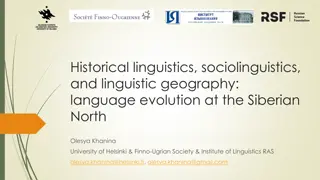
Language Change in Related Languages: A Case Study
Explore the complexities of language change through the case study of related languages in contact, shedding light on the interplay between inheritance and contact, and the challenges in distinguishing between them.
Download Presentation

Please find below an Image/Link to download the presentation.
The content on the website is provided AS IS for your information and personal use only. It may not be sold, licensed, or shared on other websites without obtaining consent from the author. If you encounter any issues during the download, it is possible that the publisher has removed the file from their server.
You are allowed to download the files provided on this website for personal or commercial use, subject to the condition that they are used lawfully. All files are the property of their respective owners.
The content on the website is provided AS IS for your information and personal use only. It may not be sold, licensed, or shared on other websites without obtaining consent from the author.
E N D
Presentation Transcript
From subgrouping debates to understanding language change: a case-study of related languages in contact Olesya Khanina (University of Helsinki) Valentin Gusev (University of Hamburg)
Introduction + Based on a submitted paper From structural isoglosses to patterns of spread: tracing inheritance and contact in Northern Samoyedic + Related languages in historical linguistics > internal subgrouping of a family + Geographic separation as the default case in conceptualizing language change + Research on contact among related languages can be illuminating in many aspects + possibly the most common in human history, + complex interplay between inheritance and contact, + the very premises of language differentiation e.g. Aikhenvald 2002, Dench 2001, Harrison 2003, Johanson & Robbeets 2012, Epps et al. 2013, Law 2014, 2020, Kossmann 2020, Mansfield et al. 2023, Beck 2023.
Related languages in contact +speakers of diversifying languages often interact with each other after the break off from the protolanguage conflicting isoglosses: features can be shared among related languages not because of a common intermediate protolanguage, but as a consequence of contact +pattern borrowing complicate the matter: it might become even theoretically impossible to disentangle effects of inheritance vs. contact (e.g. Law 2020)
Northern Samoyedic: the basics +Samoyedic (< Uralic): 10 languages, 6 (!) subgrouping hypotheses +Northern Samoyedic: an areal grouping ( Samoyedic spoken in the north ): 5 languages
Northern Samoyedic: the basics +based on cognacy in (Swadesh) wordlists and on common sound changes: (Janhunen 1975-1976, 1998, Helimski 2022, Mikola 2004) +cases of shared features contradicting the tree have also been discussed (Helimski 2022, Urmanchieva 2008, 2023, Khanina 2022, Khanina & Gusev In Press.)
What we did +An original method of tracing similarities and differences between related languages in a holistic and consistent manner +equal level of representation for all languages and all phonological & morphological changes, not just interesting cases +Data: +previous literature (phonology), +grammatical descriptions (morphology: 2 languages), +years of fieldwork and custom-fit corpora searches (morphology: 3 languages) A list of post-Proto-Samoyedic changes in Northern Samoyedic We filtered out changes which occurred in one or in all languages. We took relative numbers of shared changes as proxies for joint evolution. We contrasted phonological and morphological changes.
Sound changes in NS: expected (1) Tundra Enets and Forest Enets changes a. * > n word-initially * mp top of the head : FN nyampa forehead ; TN nyampa; FE naba; TE naba; Ng o hu b. *m > 0 intervocally (in Enets occasionally *m > b, the distribution is lexical) *s m cap : FN x ma; TN s wa; FE s j; TE s e; Ng s mu *ti m fathom : FN tyimya,TN ty bya,FE ibi,TE t iee, Ng t iimi c. *rw > m *we rw chief : FN wye w , TN yerw , FE bemo, TE bi mo, Ng baarb d. all consonants, except j, > word finally *a : FN ny ; TN nyah; FE na -a (Der); TE e ; Ng a *se r white; ice : FN x ; TN ser; FE si ; TE si ; Ng si r + 7 more
Sound changes in NS: unexpected (2) Tundra Nenets Enets changes a. *p > b intervocally *kop animal skin, fur : FN kopa; TN xoba; FE koba; TE koba; Ng kuhu b. *t, * > intervocally, *ut hand,arm : FN ta; TN uda [ u a], [ uda]; FE uza [u a], [uza]; TE uza [u a], [uza]; Ng t c. affricativization of *s after plosives (TN or dialectally , FE t > , TE t > t ~ ) *enetse human : FN nye sy , TN nyenecy h, FE en e , TE enet e ~ ene e , Ng ana sa d. n, > word-finally *a : FN ny ; TN nya ; FE na a (Der), na (Helimski Ms.); TE e ; Ng a
Morphological changes in NS Types of innovations Quantity emergence of a new morpheme 36 Historical: involving related morphemes 57 development of similar patterns of use 15 loss of a Proto-Samoyedic morpheme 6 Typological: similarities without direct relatedness similar grammatical phenomena 11 11 Total 68
Morphological changes in NS: expected (3) Forest Nenets and Tundra Nenets isoglosses 8: 6 historical, 2 typological a. "Emphatic optative" *-r m ~ *-r : FN - ama ~ - a, TN -r wa ~ -ra emergence of a new morpheme b. Habitual *-s' t : FN -sy t , TN -sy t emergence of a new morpheme c. "Suppositional past": *-m j -r k : FN -m -r xa, TN -wi -r ka emergence of a new morpheme d. Some markers from the Reflexive conjugation used for the Subjective conjugation 1Du.s *-ni : FN -j, TN - nyi ; 2Du.s *-ti : FN -ty, TN -tyi ; 2Pl.s *-ta : FN -ta , TN -da similar patterns of use of related morphemes e. 2 and 3 person pronouns based on *pi t 'body; self': FN pit -, TN pid - similar patterns of use of related morphemes f. Verbalization of *-r k as Approximative: FN -r xa, TN -r ka: its use without participle markers before similar patterns of use of related morphemes g. Finite use of participles in evidential functions (with verbal cross-reference) similar grammatical phenomena h. Idiosyncratic markers for reflexive jussive similar grammatical phenomena
Morphological changes in NS: unexpected (4) Enets and Nganasan isoglosses 7: 6 historical, 1 typological a. Probabilitive *-btV: FE, TE -ta, Ng -bta emergence of a new morpheme; Enets has regular Probabilitive category, Nganasan has a clitic: they are similar in meaning, but vowel correspondence are unclear b. Habitual *-mumpV: FE -obi, TE - bi, Ng -mu ha emergence of a new morpheme c. Anterior converb *kaj(a)-Inf: FE, TE -xaja-Inf, Ng -kaj-Inf emergence of a new morpheme (though in TE andNg the converb has very low frequencies) d. 3Sg.R *-t n: FE, TE -zo ~-z , Ng - emergence of a new morpheme e. Simultaneous converb *pu -: FE, TE -bu , Ng -h emergence of a new morpheme f. Auditive is formally identical to plural possessive forms of noun (e.g. for 3Sg: FE, TE -munu-za, Ng -munu- jt ) - similar patterns of use of related morphemes g. Soft/Future imperative *-kua: FE -ku-ri, TE -kua, Ng -ku ~ -ku similar grammatical phenomena
Morphological changes in NS Phonological domain 25 (68%) Morphological domain 36 (53%) Number of changes spread along the genealogical tree (N, E, or NE) Number of changes challenging the tree, but explainable from the geography (E-Ng, TE-Ng, N- FE, TN-E, or TN-FE) Number of the other changes (TN-FE-Ng, FE-Ng, N- TE) Total 10 (27%) 29 (43%) 2 (5%) 3 (4%) 37 (100%) 68 (100%)
Contact-induced changes in morphology +In situation of contact between unrelated languages, morphological borrowing is a rare case, placed at the furthest edge of the borrowability hierarchy (Thomason 2001). +In contrast, scholars studying language contact among related languages have suggested that restrictions on morphological borrowing in this case are much less visible, be it the form or the pattern (Epps et al. 2013, Mithun 2013, Law 2013, 2014, 2020, Al- Jallad 2013, Beck 2023). +Unlike in some of the languages, NS do not show a single case of a wholesale borrowing of a morpheme, with its sound shape belonging to the source language.
Why areas of dissemination may differ for phonological and morphological changes? +Contrastive timing and stages of interactions between language communities: + E.g. an increase in physical or social distance > separate phonetic changes, though yet too scarce to impede mutual understanding, + later a decrease in physical distance but persistence of social distance > copying in morphology are more probable then in phonology +Dissemination of a pattern expressed by a cognate matter (Pat-El 2013, Law 2020). +Dissemination of frequency of a pattern, cf. a minor use pattern to a major use pattern by Heine & Kuteva (2005) + Both are most possible in the morphological domain: unlike related phonemes, related morphemes have functions which can be copied.
An updated tree Lexical data support the tree: multi-directional borrowings within NS (Kaheinen 2023, Urmanchieva 2023)
An updated tree +The tree not as a model of change, but as a graphical representation of relatedness (e.g. Garett 1999, 2006, Chappell 2001, Harrison 2003, McMahon & McMahon 2005, Heggarty et al. 2010, Drinka 2013, Good 2023, Smith 2023). +Northern Samoyedic languages were hardly ideologically reified as separate languages, but formed dialect continua along which innovations could spread in any directions. +Nomadic people with changing routes > constant change of neighbours
Socio-cultural grounding +Sociolinguistic evidence available for the last 200 years (Khanina 2021). +Convergence: + wide-spread multilingualism and numerous multidirectional shifts within NS, + a particular type of language ideologies: + unstable connection of local social categories/groups to languages, + authenticity of the speech communities based on linguistic repertoires, not on command of individual languages, + identities: relational linguistic indexing which depended on neighbourhood-based social networks more than on ancestry. +Divergence: + breaks in interactions and disappearance of intermediate lects (natural diasters, climate fluctuations, epidemics, etc.) + language shifts > substrate influence; language shifts > new identities
Conclusion +In Northern Samoyedic, phases of divergence alternated with wave-like spread of patterns. +Sharing of some innovations in related languages is a signal of initial joint development (> the same branch) only if there were no later contacts. +If there were contacts, only a full coverage of the linguistic systems is informative: phonological, morphological, and lexical isoglosses need to be studied together to elucidate stages of joint and separate development. +Continuous diversification under intermittent contact could have been ordinary in the pre-neolithic past, so language families whose speakers were nomadic within the time frame attainable for historical comparative method are worth of particular attention.
References Aikhenvald, Alexandra Y. 2002. Language Contact in Amazonia. Oxford: Oxford University Press. Al-Jallad, A. 2013. Arabia and areal hybridity.Journal of Language Contact 6(2). 220-242. Beck, D. 2023. Morphological diffusion and the internal subgrouping of Central Totonac. Language Dynamics and Change 14(1). 1-52. Chappell, Hilary. 2001. Language contact and areal diffusion in Sinitic languages. In Alexandra Y. Aikhenvald and Robert M. W. Dixon (eds.), Areal diffusion and genetic inheritance: Problems in comparative linguistics, 328-357. Oxford: Oxford University Press. Dench, Alan. 2001. Descent and diffusion: The complexity of the Pilbara situation. In Alexandra Y. Aikhenvald and Robert M.W. Dixon (eds.), Areal diffusion and genetic inheritance: Problems in comparative linguistics, 105-133. Oxford: Oxford University Press. Drinka, B. 2013. Phylogenetic and areal models of Indo-European relatedness: The role of contact in reconstruction.Journal of Language Contact 6(2). 379-410. Epps, Patience, John Huehnergard & Na ama Pat-El. 2013b. Introduction: Contact among genetically related languages. Journal of Language Contact 6(2). 209-219. Garrett, Andrew. 1999. A new model of Indo-European subgrouping and dispersal. Berkeley Linguistics Society 25. 146-156. Garrett, Andrew. 2006. Convergence in the formation of Indo-European subgroups: Phylogeny and chronology. In Peter Forster & Colin Renfrew (eds.). Phylogenetic methods and the prehistory of languages, 139-151. Cambridge: McDonald Institute for Archaeological Research. Good, Jeff. 2023. Trees, waves, and magnets? Language change in small-scale multilingual societies, In Darya Kavitskaya & Alan C. L. Yu (eds.), The life cycle of language: past, present, and future, 386-398. Oxford: Oxford University Press. Harrison, S.P. 2003. On the limits of the comparative method. In Brian D. Joseph & Richard D. Janda (eds.). The handbook of historical linguistics, 213-243. Malden: Blackwell. Heggarty, Paul, Warren Maguire & April McMahon. 2010. Splits or waves? Trees or webs? How divergence measures and network analysis can unravel language histories. Philosophical Transactions of the Royal Society B: Biological Sciences 365. 3829-3843.
References Heine, B. & Kuteva T. 2005. Language Contact and Grammatical Change. Cambridge University Press. Helimski, Eugen. 1997/2022. Zur Stellung des Matorischen innerhalb der samojedischen Sprachen. Materials to a paper read on May 16, 1997 in the Finno-Ugric Society, Helsinki. Commented and published by Anna Urmanchieva. In Alexander Anikin,Valentin Gusev & Anna Urmanchieva (eds.). 2022. Siberica et Uralica: to the memory of Eugen Helimski (Studia Uralo-Altaica 56). Szeged: University of Szeged, 479-495. Janhunen, Juha. 1975-1976. Adal kok az szaki-szamoj d hangt rt nethez. Vokalizmus: az els sz tagi mag nhangz k. N prajz s Nyelvtudom ny 19-20. 165-188. Janhunen, Juha. 1998. Samoyedic. In Daniel Abondolo (ed.), The Uralic Languages, 457-479. London: Routledge. Johanson, Lars & Martine Robbeets (eds.). 2012. Copies versus cognates in bound morphology. Boston: Brill. Kaheinen, Kaisla 2023. Etymologia ex silentio: Nganasanin nnehistoria ja kielikontaktit. Helsinki: University of Helsinki Doctoral dissertation. Khanina, Olesya & Valentin Gusev. In press. Towards an integrated account of the history of Northern Samoyedic. In: Nikolaos Lavidas & Ioanna Sitaridou (eds.). Towards a holistic understanding of language contact in the past (Trends in Linguistics [TiLSM]). Berlin: Mouton De Gruyter. Khanina, Olesya. 2021. Language and ideologies at the Lower Yenisei (Siberia): reconstructing past multilingualism. International Journal of Bilingualism 25(4). Special issue 'Typology of small-scale multilingualism' guest edited by Nina Dobrushina, Olesya Khanina & Brigitte Pakendorf, 1059 1080. Kossmann, Maarten. 2020. Berber, In: Rainer Vossen & Gerrit J. Dimmendaal (eds.), The Oxford Handbook of African Languages (Oxford Handbooks). Online edition: Oxford Academic, 7 May 2020, https://doi-org.libproxy.helsinki.fi/10.1093/oxfordhb/9780199609895.013.37, (16 June, 2024). Law, Danny. 2013. Inherited similarity and contact-induced change in Mayan Languages. Journal of Language Contact 6(2). 271-299. Law, Danny. 2014. Language contact, inherited similarity and social difference: The story of linguistic interaction in the Maya lowlands. Amsterdam: Benjamins. Law, Danny. 2020. Pattern borrowing, linguistic similarity, and new categories: Numeral classifiers in Mayan.Morphology 30. 347-372. Mansfield, John, Henry Leslie-O Neill & Haoyi Li. 2023. Dialect differences and linguistic divergence: A crosslinguistic survey of grammatical variation. Language Dynamics and Change 13(2), 232-276. McMahon, April & Robert McMahon. 2005. Language classification by numbers. Oxford: Oxford University Press
References Mikola, Tibor. 2004. Studien zur Geschichte der samojedischen Sprachen (Aus dem Nachlass herausgegeben von Be ta Wagner-Nagy) (Studia Uralo-Altaica 45). Szeged: SzTE Finnisch-Ugrisches Institut Mithun, Marianne.2013. Challenges and benefits of contact among relatives: Morphological copying. Journal of Language Contact6(2), 243-270. Pat-El, Na ama. 2013. Contact or Inheritance? Criteria for distinguishing internal and external change in genetically related languages. Journal of Language Contact 6(2), 313-328. Smith, Alexander. 2023. Evidence and models of linguistic relations: Subgroups, linkages, lexical innovations, and Borneo. Oceanic Linguistics 62(2). 324-365. Thomason, Sarah Grey. 2001. Language contact: An introduction. Edinburgh: Edinburgh University Press. Urmanchieva, Anna 2023. Rekonstrukcija lingvicticheskogo landshafta Zapadnoj Sibiri (na materiale samodijskix jazykov). Moscow: HSE University doctoral dissertation. Urmanchieva, Anna. 2008. Konvergencija, maskirujuschaja divergenciju: eneckie dialekty i neneckij jazyk. Paper presented at the 2nd International conference on Samoyedic studies. Saint-Petersburg, October 2008.






















